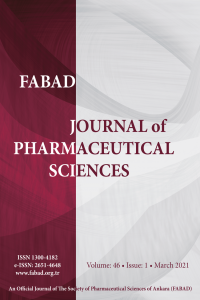Phase Transformation of Anhydrous to Dihydrate Carbamazepine: Preparation and Comparative Characterization
Phase Transformation of Anhydrous to Dihydrate Carbamazepine: Preparation and Comparative Characterization
carbamazepine, dihydrate, solubility, intrinsic dissolution rate, polymorphism,
___
- Apih, T., Žagar, V., & Seliger, J. (2020). NMR and NQR study of polymorphism in carbamazepine. Solid State Nuclear Magnetic Resonance, 107, 101653. https://doi.org/10.1016/j.ssnmr.2020.101653
- Barakh Ali, S. F., Rahman, Z., Dharani, S., Afrooz, H., & Khan, M. A. (2019). Chemometric models for quantification of carbamazepine anhydrous and dihydrate forms in the formulation. Journal of Pharmaceutical Sciences, 108(3), 1211–1219. https://doi.org/10.1016/j.xphs.2018.10.023
- ISSN: 1300-4182
- Yayın Aralığı: Yılda 3 Sayı
- Başlangıç: 2005
- Yayıncı: FABAD Ankara Eczacılık Bilimleri Derneği
Mucoadhesive Drug Delivery Systems for Pediatric and Geriatric Patients
Arya RAİ, Shristhi Sohan RAWAT, Ritu RATHİ, Deepika RAİNA, Oluwatoyin A. ODEKU, Inderbir SİNGH
Çağatay OLTULU, Melek AKINCI, Elvan BAKAR
Yaren KAHVECİ, İnci Selin DOĞAN, Şeyda KANBOLAT, Bahittin KAHVECİ
Anayatollah SALİMİ, Ramin NOORAFROOZ, Maryam FOULADİ, Saeed MOHAMMAD SOLEYMANİ
Kamlesh J WADHER, Vaishnavi RAUT, Keshav HİRAVE, Sagar TRİVEDİ, Milind UMEKAR
Üçlü negatif meme kanseri hücrelerine folik asit polietilenimin polipleksleri ile gen aktarımı
Anticancer Potential of Novel Nanoemulgel Formulations in Melanoma
